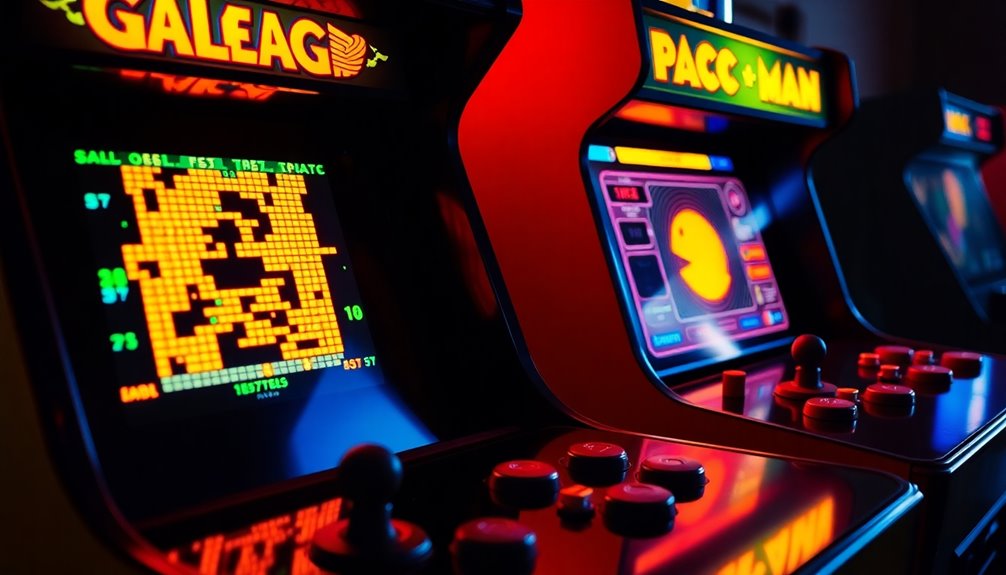The initial arcade games, such as “Computer Space” and “Pong,” marked the beginning of a gaming revolution. “Computer Space” was released in 1971 as the first commercial arcade game, allowing players to control rockets and shoot missiles. Just a year later, “Pong” was released and became a huge success, simulating table tennis with easy-to-understand mechanics. This set the stage for iconic games like “Space Invaders,” which introduced shooting and strategy in 1978, and “Pac-Man,” which expanded the gaming audience in 1980. Each game had a significant impact on the industry, drawing in crowds to arcades and paving the way for future innovations. There is a lot more to explore about this gaming evolution.
Key Takeaways
- "Computer Space," released in 1971, was the first commercial arcade video game created by Nolan Bushnell and Ted Dabney.
- Atari's "Pong," launched in 1972, popularized arcade gaming and achieved significant commercial success.
- Taito's "Space Invaders," released in 1978, became a cultural phenomenon and boosted arcade revenues dramatically.
- "Pac-Man," introduced in 1980, diversified the arcade audience with engaging gameplay and storytelling, selling around 400,000 cabinets.
- "Donkey Kong," debuting in 1981, introduced platforming mechanics and became a significant influence on future arcade game design.
Origins of Arcade Gaming
The origins of arcade gaming stretch back to the early 20th century, when amusement halls emerged with coin-operated slot machines and pinball machines. These early attractions laid the groundwork for what would become a thriving entertainment industry.
As technology progressed, the first arcade video game, "Computer Space," hit the scene in 1971. Developed by Nolan Bushnell and Ted Dabney, it drew inspiration from the earlier game "Spacewar!" from 1962, marking a significant turning point for arcade games. Remarkably, the rise of best rated pinball machines during this era showcased the innovative spirit of the gaming industry.
However, it was Atari's "Pong," released in 1972, that truly popularized the arcade gaming experience and established a commercial success that fueled the industry's growth. This pioneer captured the hearts of many and paved the way for future innovations.
By 1978, Taito launched "Space Invaders," which became a cultural phenomenon, boosting both arcade revenues and the popularity of video games as a whole.
Then in 1980, "Pac-Man" arrived, further diversifying the arcade gaming audience with its non-violent mascot character and engaging narrative elements. These key developments in the origins of arcade gaming transformed amusement halls into vibrant hubs of entertainment, forever changing the landscape of video games.
The Emergence of Computer Space

Emerging from the innovative minds of Nolan Bushnell and Ted Dabney, "Computer Space" marked a groundbreaking moment in arcade gaming history. Released in 1971, it became the first commercially available arcade video game, drawing inspiration from the earlier game Spacewar! Players engaged in two-player dogfights, controlling rockets as they shot at flying saucers displayed on a black-and-white General Electric 15-inch television.
This initial foray into arcade gaming set the stage for the development of more user-friendly machines, which would later dominate the market, as seen with Best Arcade Machines for Home Game Rooms. Manufactured and distributed in partnership with Nutting Associates, Computer Space had an initial production run of 1,500 units, with over 1,300 of those sold by 1976. Despite generating over $1,000,000 in revenue, the game's steep learning curve limited its appeal, especially among casual players. Many found the complexity overwhelming, which hindered its potential in traditional markets.
Nevertheless, Computer Space's release signified a significant turning point in the arcade industry, paving the way for future developments. This innovation laid the groundwork for Nolan Bushnell and Ted Dabney to eventually found Atari in 1972, marking the beginning of a new era in gaming.
The impact of Computer Space continues to resonate, showcasing the importance of creativity in the evolving landscape of arcade gaming.
Gameplay Mechanics of Early Games

In early arcade games, you controlled simple mechanics that shaped your gaming experience, like steering a rocket or hitting a ball with a paddle.
These games often employed basic electronic systems and introduced foundational elements of gameplay, much like how pinball machines evolved from simple mechanics to more complex designs.
Scoring systems became key, rewarding you for shooting down enemies or collecting dots, adding a competitive edge.
Plus, two-player dynamics, seen in games like Pong, made the experience even more engaging as you faced off against friends.
Basic Control Mechanics
From the very beginning, arcade games featured straightforward control mechanics that shaped player interactions. Computer Space allowed you to maneuver a rocket and fire missiles, setting the stage for engaging gameplay. The basic controls established in this first arcade game paved the way for the evolution of arcade gameplay, illustrating how nurturing an imaginative mindset can enhance player experiences.
When Pong launched in 1972, players used knobs to adjust their paddles vertically, simulating table tennis gameplay in a simple yet addictive way.
Space Invaders, introduced in 1978, took things further with control mechanics that let you move horizontally and shoot at descending aliens, enhancing the interactive gameplay experience.
The release of Pac-Man in 1980 showcased a maze chase mechanic, requiring you to navigate through a labyrinth, consuming dots while avoiding ghosts. This added complexity to player control.
Later, Donkey Kong debuted in 1981, introducing a platforming mechanic that challenged players to jump between platforms and dodge obstacles, marking a significant evolution in arcade control mechanics.
These early games laid the foundation for future titles, demonstrating how basic controls could create engaging and memorable experiences for players.
Scoring Systems Explained
Scoring systems in early arcade games played a crucial role in shaping the competitive landscape of gaming. These systems not only tracked player performance but also created a sense of rivalry among gamers.
Take "Pong," for instance; its simple scoring mechanism rewarded players with points every time they hit the ball past their opponent, making matches intensely competitive. In "Space Invaders," players racked up scores by shooting down rows of descending aliens, with each alien type offering different point values, which encouraged strategic gameplay.
The integration of AI-driven techniques in games today further enhances these experiences, making them even more engaging and personalized for players AI technologies improve threat detection in cybersecurity.
"Pac-Man" revolutionized scoring by introducing a more complex system. You earned points for consuming dots, power pellets, and even ghosts, with bonuses for clearing levels and accumulating consecutive ghost captures. This layered scoring made every game unique and exciting.
Moreover, many early arcade games, like "Donkey Kong," incorporated high score tracking. This feature allowed you to compete for top positions on scoreboards, fostering a strong sense of community and competition in arcade settings.
Two-Player Dynamics
During the early days of arcade gaming, two-player dynamics became a key feature that set the stage for competitive interaction. Games like "Computer Space" and "Pong" allowed two players to engage in thrilling competitive gameplay.
In "Computer Space," you controlled a rocket, shooting at flying saucers, but the real excitement came when another player jumped in, turning it into a head-to-head battle. This interactive engagement mirrored the social dynamics often seen in astrology and attractiveness, where interpersonal connections can enhance enjoyment and competition.
"Pong," recognized as the first commercially successful arcade game, took the two-player mode to another level. You'd control paddles to strike a ball back and forth, creating an addictive and straightforward experience that drew players in.
The modified control panels with joysticks made simultaneous play easy, fostering intense competition in arcades.
These early games emphasized simple mechanics that made it easy for you to learn and interact with others. This design encouraged social interaction, as friends and strangers alike gathered to compete, share laughs, and even trash talk.
The two-player dynamics of "Computer Space" and "Pong" not only shaped arcade gaming but also established a culture of camaraderie and rivalry that continues to thrive in gaming today.
Influence of Spacewar

isn't just a piece of gaming history; it laid the groundwork for what would become the arcade gaming phenomenon. Spacewar!, created in 1962 by Steve Russell and his team at MIT, introduced gameplay that involved two players piloting spaceships in a thrilling dogfight. This innovative concept captured imaginations and set the stage for the evolution of arcade games, reflecting the importance of philosophical exploration in understanding the dynamics of competition and interaction.
Nolan Bushnell recognized the potential of Spacewar! and sought to bring its excitement to the masses. He developed Computer Space in 1971, the first commercial arcade game, directly inspired by the mechanics of Spacewar!. This coin-operated adaptation allowed players to experience the same exhilarating gameplay in a public setting, paving the way for more arcade games to follow.
The influence of Spacewar! extended beyond its mechanics; it showcased the viability of video games as entertainment, igniting interest in the burgeoning gaming industry. As developers embraced its two-player dynamic and competitive spirit, arcade gaming began to flourish, leading to the iconic games we're familiar with today.
Spacewar! truly shaped the landscape of gaming, proving that a simple concept could have far-reaching effects.
Initial Commercial Success

When you look at the initial commercial success of arcade games, it's clear that pioneering titles played a vital role in shaping the market.
Games like "Pong" and "Space Invaders" not only captivated audiences but also generated impressive revenue, creating a ripple effect in the gaming industry.
Understanding the dynamics of market reception helps you see how these early successes laid the groundwork for future innovations.
Additionally, the financial principles of budgeting for entertainment can help individuals manage their spending on gaming, ensuring that enjoyment doesn't lead to overspending.
Pioneering Titles Emergence
The emergence of pioneering arcade titles marked a turning point in the gaming industry, capturing the excitement of players and generating considerable profits. It all began with "Computer Space," the first commercial arcade game, launched in 1971. Inspired by "Spacewar!" from 1962, it laid the groundwork for future successes.
Remarkably, the shift towards engaging and high-quality content in gaming experiences mirrored trends in online content strategies, as content relevance and authority are prioritized in holistic SEO. Just a year later, Atari introduced "Pong," which became the first major success in the arcade sector, raking in over $40 daily per machine.
The momentum continued with Taito's "Space Invaders" in 1978, which not only established the shoot 'em up genre but also sold over 100,000 machines in Japan during its launch year, greatly boosting revenue for arcade operators.
Namco's "Pac-Man," released in 1980, diversified the market with its non-violent gameplay, selling around 400,000 cabinets by 1982 and becoming a cultural icon.
Then came Nintendo's "Donkey Kong" in 1981, which introduced Mario and played a vital role in shaping the platformer genre.
Together, these titles contributed to the golden age of arcade gaming, setting a high standard for commercial arcade games and paving the way for the future of interactive entertainment.
Market Reception Dynamics
Initial commercial success in the arcade gaming industry showcased the power of innovation and player engagement. The launch of Computer Space in 1971 marked the arrival of the first commercial arcade video game, but its complexity limited its broader appeal.
To enhance player experience, manufacturers began exploring various engaging formats, similar to how yoga practices can alleviate stress and enhance focus. In contrast, Pong, released in 1972, quickly became a popular arcade sensation, generating over $40 daily per machine, a clear indicator of its commercial success.
As arcade game manufacturers refined their offerings, titles like Space Invaders emerged, selling over 100,000 machines in Japan and cementing itself as a cultural phenomenon. This success notably boosted arcade revenues and demonstrated effective market reception dynamics.
The introduction of Pac-Man in 1980 further revolutionized the landscape, leading to the sale of approximately 400,000 arcade cabinets by 1982.
Revenue Generation Impact
In the arcade gaming industry, early titles like Pong and Space Invaders dramatically shaped revenue generation, turning arcades into profitable ventures. Pong, recognized as the first commercially successful arcade game, generated over $40 daily per machine, making it a cultural phenomenon that boosted Atari's revenue markedly.
Following Pong, titles like Space Invaders emerged, selling over 100,000 machines in Japan and more than 60,000 in the U.S. by 1980. This surge contributed to the arcade industry's rapid growth during its golden age.
Pac-Man, released in 1980, became the best-selling arcade game of its time, with approximately 400,000 cabinets sold by 1982. Its immense popularity led to extensive merchandise sales, further solidifying its cultural impact.
The introduction of new genres, particularly the shoot 'em up genre established by Space Invaders, fueled increased foot traffic and revenue generation in arcades across the U.S. and Japan.
These early games not only transformed the arcade landscape but also laid the groundwork for future innovations, ensuring a lasting legacy in the gaming industry.
Challenges Faced by Early Games

Traversing the early landscape of arcade gaming presented a myriad of challenges that developers had to address to make their creations appealing. Early arcade games often faced significant hardware limitations, with custom-built components required due to high costs and the complexity of existing computers. This alteration, exemplified by Nolan Bushnell's shift to custom hardware for Computer Space, showcased the struggle for innovation. These limitations pushed developers to think creatively, leading to innovations that would redefine the gaming experience. The adoption of custom hardware allowed for specialized optimizations, which made early arcade games superior graphics explained through a focus on maximizing visual performance within constrained systems. This relentless drive for better aesthetics and smoother gameplay set the stage for arcade gaming’s golden age, captivating audiences worldwide.
Moreover, the steep learning curve of these games deterred casual players, limiting their appeal in conventional venues. Many games suffered from confusing controls and gameplay mechanics, prompting developers to rely heavily on player feedback during playtests to enhance user experience. The lack of interest from major arcade manufacturers also hindered production, leading to partnerships like Bushnell's with Nutting Associates.
Lastly, monetization efforts proved challenging. Developers like those behind Spacewar! struggled to generate revenue, creating hurdles for ongoing development. Here's a brief overview of some challenges faced:
| Challenge | Impact on Development | Solution |
|---|---|---|
| Hardware limitations | High costs, slow innovation | Custom hardware solutions |
| Confusing controls | Low user engagement | Player feedback adjustments |
| Monetization issues | Difficult to sustain growth | Seeking partnerships |
| Lack of manufacturer support | Limited production scale | Collaborative ventures |
The Role of Pinball Machines

Pinball machines revolutionized the gaming scene when they first appeared in the 1930s, quickly becoming stars in amusement halls.
Their unique blend of skill and chance not only attracted players but also set the stage for the evolution of arcade games.
As you explore their impact, you'll see how pinball influenced the design and mechanics of future arcade cabinets.
Evolution of Pinball Machines
Emerging from the shadows of early gaming, pinball machines have greatly shaped the arcade landscape since their inception in the 1930s. These machines introduced skill-based gameplay, enticing players with their mechanical features and engaging mechanics.
In the 1960s, the arrival of electro-mechanical games marked a significant turning point, with titles like Sega's Periscope (1966) showcasing new technological advancements that influenced arcade design.
By the 1970s, pinball machines evolved again, changing into solid-state technology. This shift enhanced their appeal through improved graphics and sound effects, creating a richer experience for players.
Despite facing bans in many venues from the 1940s to the 1960s due to gambling concerns, pinball machines eventually gained recognition as a legitimate form of entertainment, solidifying their place in the arcade industry.
Today, the iconic status of pinball machines continues, with annual awards honoring innovative designs and gameplay. This enduring legacy highlights their lasting impact on arcade gaming, showcasing how these machines have evolved while remaining a beloved part of the gaming experience.
Popularity in Amusement Halls
The allure of pinball machines transformed amusement halls into vibrant entertainment hubs throughout the decades. Emerging in the 1930s, these machines captivated players with their mechanical gameplay and skill-based challenges.
Even during the 1940s to 1960s, when pinball faced bans in many venues due to gambling laws, it thrived in places that embraced its skillful nature.
The introduction of electro-mechanical (EM) games in the 1960s, such as Sega's Periscope, spurred technological advancements that breathed new life into arcades. Pinball machines became a central attraction, laying the groundwork for future arcade cabinets and influencing game design.
As the early 1970s rolled in, you'd see pinball coexisting with early video games, creating a diverse entertainment landscape in amusement halls.
This blend of pinball and emerging arcade games fostered a unique environment where players could enjoy both mechanical skill and digital challenges. The popularity of pinball machines not only defined the era but also set the stage for the evolution of gaming, ensuring amusement halls remained bustling with excitement and competition.
Influence on Arcade Games
As amusement halls buzzed with the energy of pinball machines, they set the stage for a new era of arcade gaming. Introduced in the 1930s, pinball machines provided early coin-operated entertainment, establishing the concept of skill-based gaming that would become essential for future games.
Despite facing bans due to gambling laws during the 1940s to 1960s, pinball thrived in many venues, paving the way for arcade acceptance.
The emergence of electro-mechanical (EM) games in the 1960s, like Sega's Periscope, showcased technological advancements that inspired the design of future arcade video games. The success of pinball machines not only demonstrated the revenue potential of coin-operated entertainment but also laid the groundwork for arcade cabinets.
This shift culminated in 1971 with the release of "Computer Space," created by Nolan Bushnell, marking the beginning of the arcade video game era.
The influence of pinball machines was undeniable, as they guided the evolution of the first arcade games, bridging the gap between traditional coin-operated entertainment and the enchanting world of video games that would follow.
The Launch of Pong

How did a simple game of digital table tennis transform the gaming landscape? When Pong launched in 1972, it marked a turning point for the arcade video games sector. Developed by Atari, this game became the first commercially successful arcade game, enthralling a wide audience of players with its straightforward yet engaging mechanics.
- Revolutionized the gaming industry
- Generated over $40 per machine daily at its peak
- Launched a wave of imitators in the commercial arcade
- Established a foundation for popular arcade games
- Paved the way for future game development
With players controlling paddles to hit a ball back and forth, Pong was accessible and fun, making it a staple in arcades. Its immediate success resulted in a surge of demand, boosting arcade revenues and transforming the landscape into a thriving industry.
The innovative design of Pong not only set the standard for subsequent arcade games but also laid the groundwork for Atari's evolution into the home console market. Ultimately, Pong redefined what arcade gaming could achieve, paving the way for future successes in the gaming world.
Cultural Impact of Arcade Games

Arcade games have left an indelible mark on popular culture, shaping not just the gaming landscape but also influencing social interactions and entertainment trends. The release of "Pong" in 1972 kicked things off, establishing arcade gaming as a mainstream pastime.
As you witnessed the rise of "Space Invaders" in 1978, it became a cultural phenomenon, drawing in millions and changing how people viewed video games. Then came "Pac-Man" in 1980, which broadened gaming's appeal and made it an icon of 1980s pop culture, leading to a wave of merchandise and media adaptations.
During the 1980s, titles like "Street Fighter II" sparked competitive gaming tournaments, turning arcade gaming into a vibrant social activity. This laid the groundwork for what we now know as esports, as players began gathering in arcades to showcase their skills and compete for glory.
Legacy of Early Arcade Games

Early arcade games laid the groundwork for the gaming industry we recognize today. These pioneering titles not only introduced gaming to the masses but also shaped the future of game design and culture.
Here's a glimpse into their lasting legacy:
- The first commercial video game, Computer Space sparked interest in arcade gaming.
- *Pong* became the first successful arcade game, igniting a popular game phenomenon.
- *Space Invaders* established the shoot 'em up genre, drastically increasing arcade revenues.
- *Pac-Man* evolved into a cultural icon, broadening the appeal of gaming, especially among women.
- *Donkey Kong* introduced Mario, a character who'd become synonymous with video game history.
The arcade golden era paved the way for modern game companies to innovate and diversify game genres.
These early games not only entertained but also laid the foundation for the diverse gaming experiences we enjoy today. By understanding their impact, you can appreciate how far the industry has come and the cultural significance of these arcade classics.
The history of video gaming is richer because of these early pioneers, forever changing how we interact with games.
Frequently Asked Questions
Which Came First, Tetris or Pac-Man?
You'll find that Pac-Man came first, debuting in 1980, while Tetris followed four years later in 1984. Both games shaped the gaming landscape, each leaving a significant impact on players and the industry.
Which Came First, Donkey Kong or Pacman?
You'd think Donkey Kong burst onto the scene first, but nope! Pac-Man gobbled up the spotlight in 1980, paving the way for arcade glory, while Donkey Kong followed closely in 1981, forever changing gaming.
What Was the First Arcade Game Atari Made?
Atari's first arcade game was "Computer Space," released in 1971. You'd control a rocket, shooting at flying saucers. Despite its innovative gameplay, it struggled with complexity, limiting its appeal to casual players. Computer Space paved the way for other arcade games, as it marked the beginning of the history of arcade games. The game was a precursor to the wildly popular game “Pong” which was released a year later by Atari. These early games laid the foundation for the booming arcade industry that would follow in the decades to come. In the early 1980s, arcade games became a cultural phenomenon, with iconic games like “Space Invaders” and “Pac-Man” drawing in massive crowds. This period marked a significant chapter in the history of arcade games, as they became a staple of entertainment venues worldwide. The boom of arcade gaming in the 1980s established a legacy that continues to influence modern gaming and entertainment.
What Was the First 3D Arcade Game?
Incredible innovations introduced "I, Robot" as the first fully 3D arcade game. You'll navigate a stunning, polygonal playground, immersing yourself in complex controls and enchanting gameplay, though its high cost limited its widespread success.
Conclusion
In the grand tapestry of gaming, early arcade games are the vibrant threads that weave excitement and nostalgia into our lives. Just like the first time you hit the sweet spot on a pinball machine, sending the ball flying, these games sparked a revolution. Remember how you felt when you first played Pong? That simple, yet addictive gameplay mirrored the joy of discovering a hidden treasure, laying the foundation for the gaming world we recognize today.









